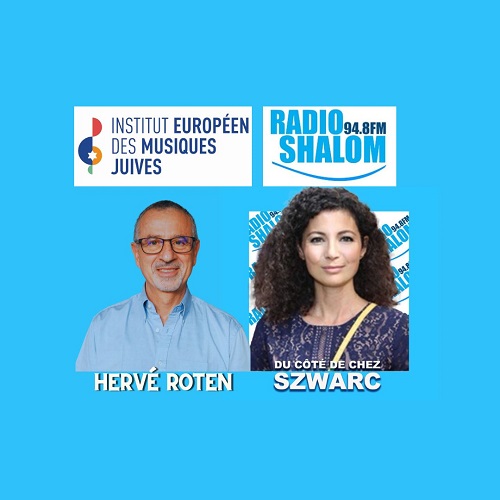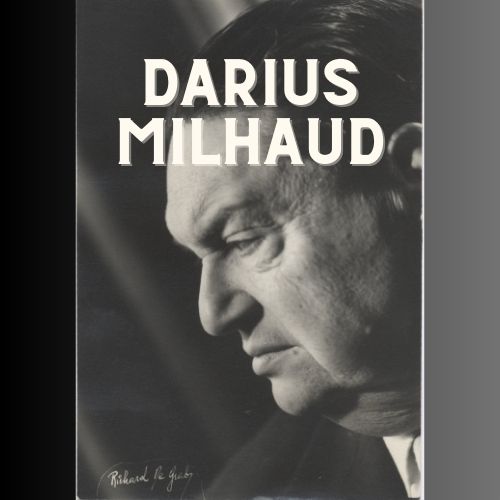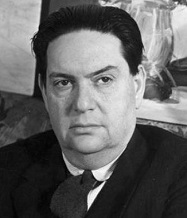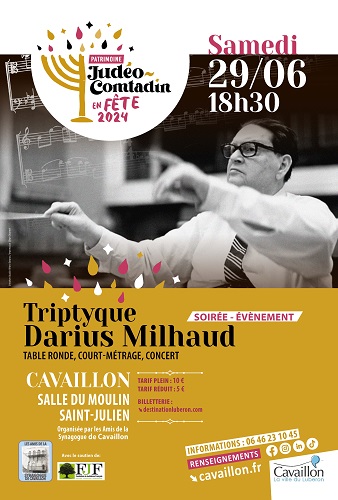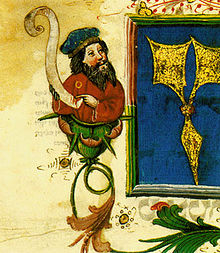
By Hervé Roten
A history of over 20 centuries
The origins of the Jewish community of France is quite old. It is in the year 6 A.D. that Archelaus, Ethnarch of Judea, banned by the Roman Emperor Augustus, settled down in the city of Vienne (Isère), a commune in southeastern France. Under the Merovingian dynasty, Jewish families settled their homes in Frank territories. During the following centuries, these groups, that were often small, developed or disappeared.
At the dawn of the French revolution, the Jewish community counted about 40,000 people, mainly established in Alsace-Lorraine, in the Comtat Venaissin and in the South West of France. With the emancipation, French Judaism absorbed during the 19th century elements from Central Europe, especially from Germany. In 1880, the pogroms that took place in Russia provoked the emigration of Polish, Romanian and Russian Jews into France. From 1908, Jewish people from Ottoman countries (in particular from Thessaloniki, Constantinople and Smyrna) passed through France and sometimes settled down. Between the two wars, several successive waves brought over 100,000 Jews from Italy, Central and Eastern Europe (Germany, Austria, Hungary, Czechoslovakia, Russia, Poland, Ukraine, Latvia, Lithuania…), to which we can add Sephardi Jews from Greece and Turkey.
After the Second World War, the Jewish community of France strongly weakened. The rabbinate was wiped as well as the religious practices. One would have to wait the arrival of 200,000 Jews from North Africa, between 1956 and 1967, in order for French Judaism to begin a religious and cultural rebirth.
Today, French Judaism is strongly composite. Estimated to around 600,000 people, it is composed of a mosaic of communities and traditions with various origins.
Jewish music or music of the Jewish ?
Since the end of the 19th century, Richard Wagner, famous anti-Semite, declared that there isn’t one Jewish music but music of Jews. The musicological studies indeed brought to light the absence of any musical characteristic which would be specifically and only Jewish. In 1957, the musicologist Curt Sachs defined Jewish music in these terms «Music made by Jews, for Jews, as Jews»[1]Definition given by Curt SACHS at the World Congress of Jewish Music (Sorbonne, 1957). Cf. BAYER Bathja , Encyclopaedia Judaïca, vol. 12, p. 555.. Yet there are nowadays excellent klezmer bands, such as The Goyim, whose name suggests that this kind of music – considered by everyone as Jewish music – can be perfectly assumed by non-Jews, for non-Jews, and in a non-Jewish realm.
So there is no Jewish work by nature, but works played in a Jewish context, be it religious or secular. The many adaptations of mainstream melodies (from little songs to classical masterworks) in the synagogue liturgy testify that a music isn’t born Jewish, but becomes Jewish.
Let’s go further and say that music of Jews doesn’t exist – and never was – just a Jewish fact. But it feeds from sources of ethnicity; it takes its inspiration from a Jewish way of life… that may no longer exist. The sociologist Barbara Kirshenblatt-Gimblett brings to light a distinction between a music of tradition and a music of heritage : « I use the words « music of heritage » in order to establish a distinction between a music that is an integral element of a way of life and a music that was chosen to be preserved, protected, esteemed and rediscovered, to be short, a « music of heritage »[2]Cf. KIRSHENBLATT-GIMBLETT Barbara, « La renaissance du klezmer : réflexions sur un chronotope musical », Cahiers de Littérature Orale, n°44, 1998, pp. 232-233.
That is how many professional musicians perform, for a curious audience, or in search of identity, music which seems to be more folkloric than lived experience, more of heritage than tradition. These artists are in fact not necessarily specialized in a unique tradition. They don’t hesitate to reappropriate repertoire which are easily changeable, playing for example Yiddish songs followed by Judeo-Spanish music.
Nowadays, music stores propose many discs, where the best stands beside the worst ; but all these recordings testify of a recovered vitality. There are many shows and concerts dedicated to Jewish music. But since when ?
The Jewish music practices in France : a historical overview
Of all times, there was Jewish music in France – be it liturgical chants, lullabies, circumcision, work or wedding songs – but the small number of people in the communities (sometimes just a few families), the persecutions and expulsions had the effect of rejecting this music of oral tradition into oblivion. One would have to wait the 18th century, and especially the 19th century for Jewish music to be written down for the first time[3]Cf. ROTEN Hervé, Musiques liturgiques juives : parcours et escales, Coll. Musiques du monde, Cité de la Musique / Actes Sud, 1998, 167 p. et 1 CD.
However, since the beginning of the 17th century, a reformed current, aiming to offer an art music to Judaism, wander in various communities of Western Europe : in Venice, Salomone Rossi published his Salomon’s canticles ; in Amsterdam, the cantatas by Giusepe Lidarti or Abraham Caceres illustrate the splendor of a community at the peak of its glory. In France, the emancipation of 1791 and the consistorial reform of 1808 encouraged the Jews from the Comtat Venaissin, the Portuguese from southeastern France, and the Ashkenazi mainly settled in Alsace-Lorraine to write down their traditional tunes and to adopt a polyphonic music modelled on Western music.
Just like the German reformed cult preached by Moses Mendelssohn, the French consistorial temples set up a policed cult where the cantor, accompanied by a choir of men and children, sang solemnly the prayer. The accompaniment of services with the organ would eventually be officialized in 1844 by the great rabbi Salomon Ullman, and the choirs would become mixed starting in the 1920’s. In Paris, consistorial schools mainly provided the children choirs, especially the students from the school Lucien de Hirsch who sang for a long time in the choir of the synagogue in the rue Buffault.
It was still in the synagogue that composers such as Fromental Halévy (1799-1862), Charles Valentin Alkan (1813-1888) and Jacques Offenbach (1819-1880) received their first musical initiation. But with the emancipation, the core of their works was expressed outside the synagogue. Having not been able to hold its most talented musicians, the synagogue saw its young talents leave one after the other.
The migration flows in the beginning of the 20th century brought considerable changes in the Jewish musical practices in France. Jews from Poland, Romania, Russia, Italy, Germany, etc., to which we can add Sephardi Jews from Greece and Turkey, settled in France and brought their culture from where they came from. Among them are many musicians, such as Joseph Kosma or Francis Lemarque, very active in the renewal of French song in which they injected elements of Jewish music from Eastern Europe. At the same time, Darius Milhaud, proud of his Comtadine roots, wrote several works of synagogue music (Sacred Service, Ani maamin). In search of new musical expression, non-Jewish composers – such as Max Bruch or Maurice Ravel – composed works, like Kol Nidrei, Kaddisch, from Jewish traditional melodies that they transcend to give them a universal dimension.
In the 1920’s, people talked and sang in Yiddish in the textile shops of the Jewish Parisian district, the Sentier. Then, after the Second World War, and the arrival of 200,000 North African Jews, between 1956 and 1967, Judeo-Arabic songs took the place of Yiddish. From 1968, North African Jews rejected the consistorial musical aesthetics and preferred a more orthodox Judaism ; the accompaniment with the organ was abandoned during services, and mixed choirs were progressively removed.
With the disaffection of worshippers for the cult and assimilation, the Jewish musical practices have been on the decline. But in what shapes do we find these musical practices nowadays ?
Today’s practices
The Jewish musical practices in France reflect the multicultural dimension of Judaism. From the synagogue chanting to the Yiddish folklore, from Oriental dances to Eastern Europe klezmer music, a non-prepared listener would be a bit destabilized by the heterogeneity of these musical practices. The latter divide nevertheless into two genres: religious music for an intern usage, and secular music that feeds from ethnicity.
1) Religious music
Liturgical music represents the essential of the practice of Jewish music. The singing, omnipresent in the synagogue or at home, punctuates the life of the worshipper. A religious Jew goes to the synagogue three times a day, to recite the tunes that he learned from his fathers according to oral tradition. Jewish holidays bring a musical blossoming more or less marked according to their significance and their importance in the liturgical calendar.
Since the fall of the Temple (70 A.D.), music instruments are in theory forbidden inside the synagogue (except for the Shofar : a ram’s horn in which we blow during the holidays of the new year and Yom Kippur). However, since the second half of the 19th century, the Ashkenazi sometimes use the organ to accompany the singing, outside of the periods of prohibition of Shabbat and high holidays.
The actors and keepers of this musical tradition are : the cantor (hazzan), the Rabbi and the worshippers who actively play a part in the services, because the singing often assumes a responsorial role. Among these worshippers, let’s note the importance of the Ba’ale massore[4]Literally : possessor of the tradition.. That learned man, who knows the tradition by memory, is the guarantor of a correct following of the rites and tunes sung in the synagogue. Let’s notice that these traditions, mainly monadic and from oral origin, go since the 19th century along with a polyphonic repertoire for choir, sometimes accompanied on the organ, despite the prohibition of music instruments in the synagogue since the destruction of the Temple (70 A.D.)[5]Only notable exception, the shofar is a ram horn that is blown into mainly during the celebrations of the new year (Rosh Hashanah) and the Day of Atonement (Yom Kippur)..
Each synagogue has its own musical rite. It depends on the location of the synagogue, the practice of secular traditions and the origins of the majority of the worshippers. Thus in a homogeneous community, composed exclusively of Tunisian Jews, the prayers are sung according to the Tunisian rite. In the Parisian synagogue of the rue de la Victoire, the rite is mainly Ashkenazi, but the majority of tunes come from the consistorial period … therefore quite distant from the Polish or Russian rite for example. Some communities – particularly in towns where the number of Jews is low – worshippers of varied origins gather, resulting in a mixture of various tunes and traditions (following the impact and the force of the present groups) giving birth to a ” mixed” tradition, that will be passed on.
2) Secular music
There is – in parallel to this liturgical practice – a communal musical practice. This practice claims the Jewish identity as a foundation of a musical awareness. Thus the music from Eastern Europe (Yiddish, Chasidic), oriental and Judeo-Spanish – that were once sang in everyday life – are linked to a diasporic culture who often disappeared and that we are trying to live again. These practices generally take place inside community centers, reception halls, concert halls or even cafe-theaters. The singing is the predominant part but the dance, which perpetuates Hasidic or Israeli folklore, has a significant part. To accompany the singers or the dancers, instruments such as the violin, the clarinet, the accordion or the guitar are often used.
Immersing fully into these tradition of yesteryear, the Jew of today becomes a simple participant, an exterior spectator of a culture, a folklore and an imaginary world that he knows only through such performances, and that he nurtures as a full part of his roots and Jewish identity.. Thus the Ashkenazi make live again the chants of Yiddish folklore. The Hasidim dance and express their joy with the music of orchestras that recall the ancient Eastern European orchestras (Klezmorim). Likewise, the old romances or Judeo-Spanish lullabies recall, with the guitar, the history of Salomon’s kingdom. However, the different performers of this music are often not specialists in a unique tradition. They don’t hesitate to appropriate and adapt those easily interchangeable repertoires, playing Yiddish songs followed by Judeo-Spanish tunes. This way they pick into a vast musical directory, derived from the tribulations of the Jewish people, to create a kind of legendary folklore.
Finally, a last factor of novelty: for several decades, popular Israeli songs and dances[6]Such as for example the Hora which is a dance that comes from Romania. entered into the repertoire of Jewish musical traditions in France. This music, of a popular essence, includes all the participants and are generally performed are generally performed by youth movements or during big family celebrations, such as weddings, (Bar mitsvahs), or circumcisions.
This overview brings to light the liveliness and diversity of Jewish musical practices in France. In contact with the surrounding civilizations, Jewish music absorbed many exogenous stylistic elements : thus the old biblical cantillations are found along side with medieval Andalusian poetry, East-European tunes and lyrical compositions from the 19th century. For this reason, Jewish music is like earth with fossils, composed of musical layers from various times and places, a living musical memory of humanity that is urgent to collect, study, promote, and to always recreate if we don’t want it to disappear.
| 1 | Definition given by Curt SACHS at the World Congress of Jewish Music (Sorbonne, 1957). Cf. BAYER Bathja , Encyclopaedia Judaïca, vol. 12, p. 555. |
|---|---|
| 2 | Cf. KIRSHENBLATT-GIMBLETT Barbara, « La renaissance du klezmer : réflexions sur un chronotope musical », Cahiers de Littérature Orale, n°44, 1998, pp. 232-233 |
| 3 | Cf. ROTEN Hervé, Musiques liturgiques juives : parcours et escales, Coll. Musiques du monde, Cité de la Musique / Actes Sud, 1998, 167 p. et 1 CD |
| 4 | Literally : possessor of the tradition. |
| 5 | Only notable exception, the shofar is a ram horn that is blown into mainly during the celebrations of the new year (Rosh Hashanah) and the Day of Atonement (Yom Kippur). |
| 6 | Such as for example the Hora which is a dance that comes from Romania. |
